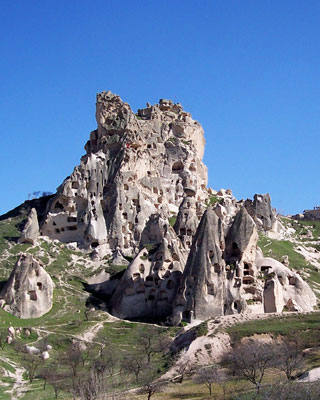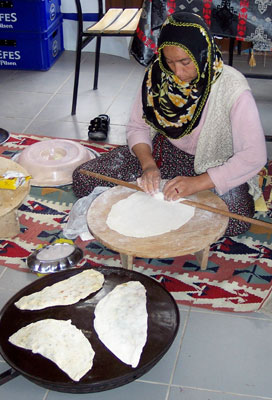Cappadocia to Bursa
This item appears on page 71 of the October 2009 issue.
by Randy Keck (Part 2 of 3 on Turkey)
My April ’09 exploration of Turkey continued with an early-morning departure inland by road from coastal Antalya to the important Roman city of Konya en route to our eventual destination, Cappadocia.
We passed through mountain ranges reminiscent of the California Sierras, stopping to frolic in the spring snow at an elevation of 5,600 feet.
Traditional Konya
Konya is nestled on a high, rather unimpressive plain in the middle of the Anatolian steppe. It was a strategic Roman city and later the capital of the Seljuk Turkish empire, reaching its heyday in the 12th century. Today it remains a very traditional, conservative city, which was clearly evident by the dress and mannerisms of the local population. Konya, however, is becoming increasingly modern and prosperous.
At the 13th-century Mevlana Museum, we were enlightened regarding the fascinating history of the Whirling Dervishes, who perform Sufi worship through singing and, particularly, whirling dancing marathons. Sufi philosophy stresses that all are part of God and all religions lead to God. It would seem that the Sufi embrace a model of religious tolerance worth replicating on a global scale.
Cappadocia astounds
The Cappadocia region looks much more like a dramatic moonscape than any of the other regions of Turkey we experienced. Its dry, barren terrain is laced with surreal, jagged rock formations. These are the result of centuries of erosion following dramatic volcanic activity 30 million years ago, when erupting volcanoes blanketed the region in ash. A unique erosion process created the distinctive formations, including the capped-cone “fairy chimneys” around Ürgüp.
Cappadocia is big-sky country where one can see vast distances, accented by massive, snowcapped Mt. Erciyes, at 12,848 feet, seemingly ever present on the horizon.
In Cappadocia we were based in the small town of Ürgüp for two days and three nights at the Dinler Hotel, a short walk from the center of the village. The Dinler appeared to be the best hotel in the area. I suggest the fifth (top) floor, as those rooms have been upgraded and have balconies.
From my top-floor terrace, I enjoyed both the evening sunsets and morning hot-air balloon cavalcade in the skies above Ürgüp. The one-hour hot-air balloon excursion was very pricey, at over $200, so I passed on that option.
Rocks of ages
Our first morning, we visited the visually staggering Göreme Open Air Museum in the Göreme Valley, preserved as a UNESCO World Heritage Site.
At Göreme we explored numerous ancient painted cave chapels and churches, dating from the ninth century, which were carved into the massive rock cliffs that permeate the lunar-like landscape. Several of the cave churches feature well-preserved frescoes. Be prepared for crowds at this popular site.
On our second day in Cappadocia we toured the fascinating cave system at the sixth- to ninth-century underground city of Kaymakli. Only rediscovered in 1964, it is believed to have housed thousands of people for temporary periods during times of conflict. Five of what are believed to be eight levels are open to visitors.
Later we moved on to the tiny, remote village of Songali, noted for producing traditional Turkish dolls. At Songali we hiked a couple of miles to the base of a towering stone escarpment to visit two cave churches and their marginally preserved frescoes. Our walking trail passed alongside miniature vineyards and apricot orchards in full bloom.
Ankara on the fly
Our whirlwind one-night visit to Turkey’s capital, Ankara, featured visits to the Museum of Anatolian Civilizations and the equally noteworthy great mausoleum of Kemal Atatürk, the revered founder of the Turkish republic.
The incumbent war history panorama exhibits at the Atatürk Mausoleum, especially those featuring the famous WWI Battle of Gallipoli, were the finest I have ever seen.
Our base in Ankara, the centrally located Radisson SAS Hotel, was user-friendly in all regards.
Bursa via Gordion
On our way from Ankara to Bursa, we detoured to Gordion (Gordium), the site where Alexander the Great cut the fabled Gordion Knot and then, as had been prophesied, went on to summarily conquer Asia. Remaining in the area today are over 90 tombs housing the remains of dignitaries, each tomb located deep inside a large, man-made hill. We visited one of the tombs, rumored to be the tomb of King Midas.
On arrival in attractive Bursa, known as Turkey’s “green city” due to its abundant rainfall, we visited the historic Green Mosque, which, unfortunately, was under repair, and the Green Tomb. We then had free time to explore Bursa’s colorful silk bazaar, a great spot to purchase lightweight silk gifts.
Our one-night stop in Bursa was at the Almira Hotel, which proved to be one of the best properties on our tour. My 40-minute massage in the hotel spa was a value at only $30.
In part three of this series on Turkey, I will report on immense, pulsating Istanbul and the ultrapopular Aegean seaside resort of Bodrum.
For information regarding traveling to Turkey, including a wide range of group and individual touring options, contact my trip hosts, FLO-USA (Lake Mary, FL; 888/435-6872, e-mail info@flo-usa.co or visit www.flo-usa.com) and Turkish Airlines (800/874-8875, thy.com).
Keck's Beyond the Garden Wall
❝ We find many answers to our origins in this sacred land
Should we be wise enough to examine closely,
prodigious insight may also be gleaned concerning the life and times yet before us❞
— Randy speculating about the prognostic modeling of modern-day Turkey


